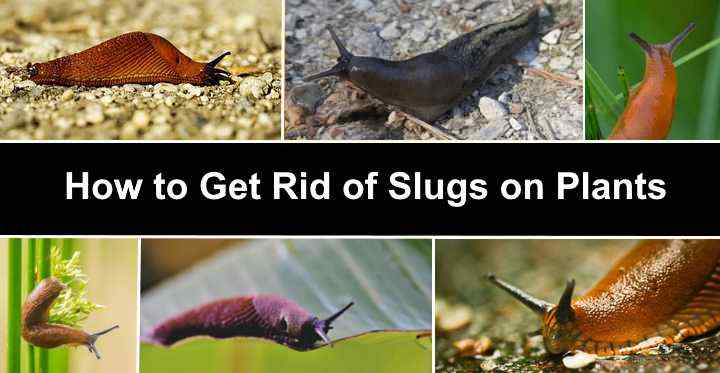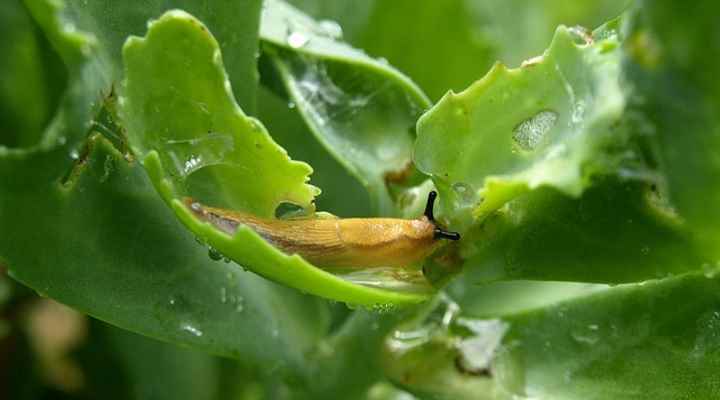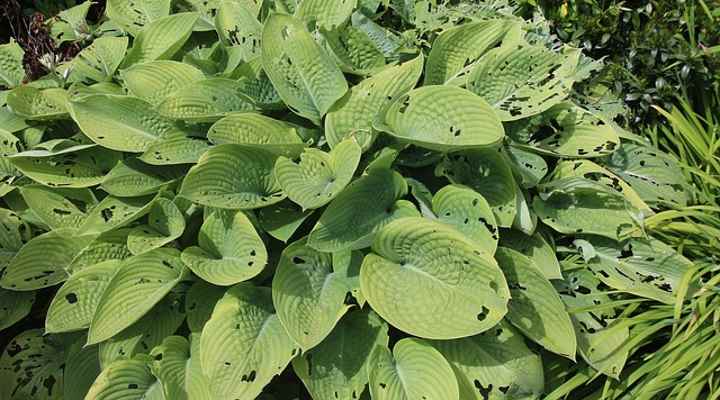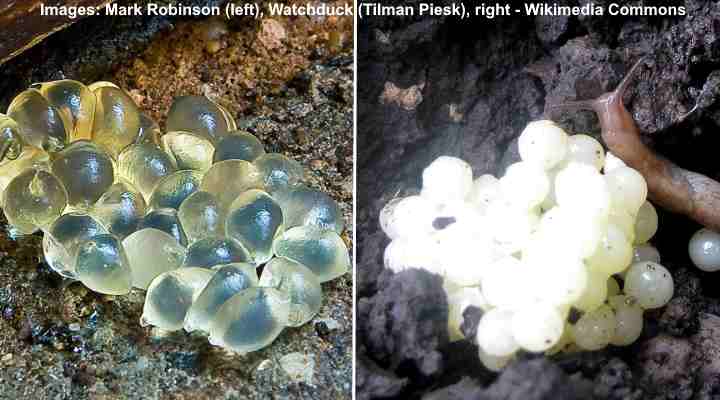Natural Ways to Get Rid of Slugs on Plants

Slugs are plant-destroying pests that eat ornamental plant leaves, vegetables, flowers, bulbs, shrubs, and fruit. Slugs damage is seen as irregular holes in foliage, stripped vegetation, and dying plants. Soft, slimy black or brown slugs do the most damage in gardens at night, especially when it’s humid.
Apart from noticing the damage that slugs do to plants, you can spot their activity by the slime trails they leave on paths and stems.
In this article, you’ll find out about the best natural ways to get rid of slugs for good. Natural slug control methods can help to reduce their numbers and stop them from eating your plants. You’ll also learn how to prevent slugs from destroying your flowers, vegetables, shrubs, and ornamental plants.
What Are Slugs?

There are many slug species that range in their look and size
Slugs are a type of land mollusk in the phylum Mollusca and class Gastropoda. Slugs produce a protective mucus that gives the soft, slippery creatures a shiny look. There are over 5,000 species of slugs. Slugs range in size from around 1” (2.5 cm) long, such as the black slug (Arion ater) to the huge leopard slug (Limax maximus) that is 8” (20 cm) long.
What Does a Slug Look Like?
A slug looks like a snail without a shell or a fat, slippery worm. Slugs are like soft cylindrical creatures with two tentacles at their head. Slugs also have a foot or belly that secretes mucus as they travel around gardens, eating vegetation. Most garden slugs are brown or black.
What Do Slugs Eat?

Slug damage to hosta plant leaves
Slugs eat plant leaves, flowers, stems, fruit, tuberous roots, and bulbs. Most slugs prefer feeding on tender leaves, and they can quickly consume seedlings. Species of slugs enjoy ornamental plants such as tulips, gerberas, delphiniums, and hostas for meals. Pesky brown and black slugs also munch through potatoes, peas, lettuce, celery, and beans.
Slugs are an essential part of many ecosystems. Even in the garden, slugs are good for some things, such as in a compost pile. However, most slug species can be serious pests and cause havoc in gardens if there are too many.
Where Do Slugs Live?
Slugs live in damp, humid conditions where there is plenty of moisture. During the day, you’ll find slugs hiding under debris, pots, mulch, rocks, and overgrown vegetation. The slimy creatures need to stay in cool, damp places so that they don’t dehydrate and dry out.
What Eats Slugs?
Knowing what creatures feed on slugs can help control the squidgy fat, worm-like mollusks. Slug predators include chickens, ducks, some birds, and toads. Even some types of beetles feed on slugs and snails. It’s probably impossible to rid your garden of slugs permanently. But encouraging animals, birds, and insects that feed on slugs can help keep their numbers under control.
Slug Eggs

Close up pictures of slug eggs
Slug eggs look like clusters of translucent or white, round, pearl-like balls with about 40 eggs in each cluster. Slugs lay eggs near the soil’s surface, usually under debris such as leaves or decaying vegetation. Slug eggs take between two and four weeks to hatch. In colder climates, slug eggs laid in October won’t hatch until the following spring.
Keeping your garden free from piles of old leaves or other organic matter can reduce the places where slugs can lay eggs. Tiling the soil can also reveal egg clusters that you can destroy to prevent eggs from hatching and then eating through your precious plants.
Slug Damage
Knowing how to spot the signs of slug damage on plants can help to eradicate these slimy pests. Nibbling holes in leaves is the most common damage that slugs do. You might see slug damage as round holes in leaves or notice that the leaves have ragged edges.
Another sign in spring that you have a slug problem is missing seedlings. Garden slugs can completely decimate tender seedlings overnight.
Slugs also attack tuberous vegetables and bulbous plants. Some types of slugs live in the ground and chew holes in the roots of crops and bulb plants. You might see that plant foliage growth is weak if slugs are munching through the roots. You may also have black or brown slugs above ground that chew leaf edges, giving them a scalloped look.
Slug Beer Trap
Beer traps are an effective and inexpensive way to kill garden slugs. Make a beer trap for slugs by half-filling a small plastic or metal container with beer and setting it on the ground to attract the slugs. Slug beer traps work by attracting small and big slugs due to the smell of yeast.
For the beer trap to be effective against slugs, you need to replenish the yeasty liquid every few days. Also, beer traps can attract beetles that feed on slugs. To prevent killing beneficial beetles, keep the lip of the trap 1” to 2” (2.5 – 5 cm) above ground level. The plant-killing slugs climb up and into the trap, fall into the beer and drown because they can’t get out.
Some gardeners say that beer traps attract too many slugs to gardens. However, others say that the odors from the yeasty brew don’t travel too far. So, you will have to see if setting out beer traps works for you.
There is also some scientific research suggesting that slug beer traps work well. Scientists compared the effectiveness of homemade slug beer traps with commercial slug traps. The results showed that beer traps caught just as many slugs as the expensive traps. The study concluded that a beer trap for slugs is a low-cost solution to get rid of slugs in a garden.
How to make a homemade beer trap for slugs
Collect a few old plastic pots with lids, such as margarine or yogurt containers. Cut a few holes around the top. Dig a hole in the ground big enough for the tub, but leaving about 2” (5 cm) above the ground. Pour about 3” (7.5 cm) of beer into each container. Put the lid on the tub.
Check the beer traps every few days for dead slugs and replenish the liquid as necessary. Although slugs look fat and slimy, some common garden slugs can stretch up to 8” (20 cm). So, they should squeeze through relatively small holes to get to their favorite tipple. The lids protect the traps from killing beneficial insects.
Slug beer trap alternative – yeast trap for slugs
You can use a yeast solution in a slug trap as an alternative to beer. Mix one tablespoon each of yeast, flour, and sugar in a cup of water. Pour the liquid into the traps to attract the slugs and kill them. You know that the yeast beer trap is working if you see fewer signs of slug damage—chewed leaves and silvery slime trails—in your garden.
How to Get Rid of Slugs
What are other natural methods effective for controlling slugs in a garden? Read on to find out what else you can do to kill garden slugs and protect your plants.
Iron Chelate to Get Rid of Slugs
Iron chelate is a cheap and effective solution to rid your garden of annoying plant-nibbling slugs. Slugs ingest chelated iron, and the substance affects the slugs’ digestive system. The affected slugs stop feeding and crawl into the ground where they die, out of sight.
Slug bait containing iron chelate is toxic to slugs but doesn’t harm wildlife, pets, or humans. You can buy natural snail bait products to use in your garden. The benefits of these iron-based slug pellets are that they continue to work in damp weather and will kill slugs and snails.
Scientific experiments using 5% iron chelate found them to be as effective as other popular molluscicides that contain toxic chemicals.
Melon Rinds to Help Get Rid of Garden Slugs
An easy way to trap slugs and kill them is to place melon rinds skin side up in your yard. Melon rinds work by creating an environment slugs like to live in. You place the inverted melon rinds at night where slugs frequent your garden. The melon attracts slugs. Then in the morning, turn the melon rinds over for birds to come and eat the slugs.
According to the University of Maryland, the melon rind method for slugs is effective. However, it requires diligence to set the slug traps every evening and then remove the slugs to kill them or let birds eat them.
Make Slug Traps Using Boards to Catch Slugs
Like using melons to trap and kill slugs, you can use boards to trap slugs. Lay the boards between crop rows in the evening. The slugs will take shelter under the boards to get protection from the sun. In the afternoon, upturn the boards to expose the slugs. Pick all the slugs and drop them into a bucket of hot, soapy water to kill them for good.
Biological Control to Kill Slugs in Your Garden
Attract slug predators to your garden to eliminate a large number of these slippery, fat creatures. Slugs are the favorite meal of many birds, especially thrushes. If you make a bird-friendly garden by installing birdhouses and birdbaths, they will reward you by eating slugs.
Another biological method of controlling slug numbers is to attract common ground beetles and fireflies. Toads and frogs also enjoy slugs as a tasty meal.
Treat Soil With Nematodes to Kill Slugs Naturally
Kill garden slugs naturally without chemicals by using slug-parasitic nematodes. The microscopic worm Phasmarhabditis hermaphrodita infects and kills a wide range of slug species. The nematodes get into the slug’s body and release bacteria. This then affects the slug’s feeding, causing it to stop eating leaves. The slugs eventually die.
Research says that using slug-parasitic nematodes is suitable for organic farming. Also, these slug and snail parasitic worms don’t affect insect species or animals.
Homemade Slug Baits for Getting Rid of Slugs
Apart from using beer to attract and kill slugs, you could try other baits to get rid of slugs naturally. For example, you could mix molasses or cornmeal with water and pour the solution into slug traps. However, there is no evidence for the effectiveness of these homemade slug baits.
How to Prevent Slugs
The best way to get rid of slugs is to prevent them from coming into your garden. Some gardening techniques disrupt the environment for slugs, making them go elsewhere to find food and lay eggs. Let’s look briefly at some of the best ways to prevent slugs.
Use Copper Barriers to Prevent Slugs
Copper barriers may prevent slugs from crawling up plants to eat their leaves, flowers, stems, and fruit. Some say that placing copper wire around plants stops slugs from coming close. The copper reacts with the slug’s slime, giving it a shock. If you use raised vegetable beds, you could try surrounding the bed’s frame with copper tape.
Although some people claim that copper barriers are highly effective, there is no proof that this works.
Avoid Mulching for Natural Slug Control
If you have a slug problem, avoid using mulch around your plants. Slugs love to hide under mulch where it’s cool and damp. Also, remove any unnecessary debris and weeds from around your ornamental bushes and plants. If you have small trees, shrubs, or plants in containers, raise the pots off the ground so that slugs don’t have anywhere to hide.
Good Gardening Habits Help Prevent Slugs in Gardens
Keeping your garden neat and tidy is a great way to discourage slugs from coming into your garden. Regular weeding is essential to prevent slugs. You should also remove any logs, boards, rocks, or plant debris that isn’t necessary.
Drip Irrigation Methods Help Reduce Slug Numbers in Your Garden
To help prevent significant slug problems in your garden, use a drip irrigation method to water your plants. Drip irrigation keeps gardens as dry as possible to avoid slugs loving your garden environment. It’s also best to water garden plants in the morning to make life unpleasant for slugs in your garden.
Diatomaceous earth could help prevent slugs
Sprinkling a layer of diatomaceous earth (DE) could help keep slugs off your plants. DE is a non-toxic pesticide that is useful for killing a range of unwanted garden insects. DE works in gardens against insects because its sharp edges cut through exoskeletons. Can you use diatomaceous earth on slugs?
Some gardeners report that slugs and snails crawl up to the diatomaceous earth barrier and don’t go any further. However, DE is only useful when it’s dry, and has no pesticide or deterrent effect when it’s damp. Usually, slugs are most active in wet weather. So, diatomaceous earth could work for snails in some circumstances.
4 Myths About Getting Rid of Slugs from Your Garden
There are many myths about what is useful for getting rid of slugs from your garden naturally. Some of the common unproven remedies for dealing with slugs include using coffee grinds, cornmeal, crushed eggs, and mulch. Eradicating garden slugs requires a multi-method approach. But it’s vital only to use methods that work.
Here are four of the biggest myths about natural ways to kill garden slugs:
Myth #1 — Coffee grounds help rid of slugs
The theory about coffee grounds for slugs is that coffee grounds act as a barrier to slugs. It’s claimed that slugs won’t cross the ring of coffee grounds around plants. However, many people who’ve tried using coffee grounds for slugs end up disappointed. Slugs tend to go straight over coffee grounds without any problem.
The myth about using coffee grounds for slugs may come from a study about caffeine sprays. Scientists found spraying slugs with 2% caffeine spray works as a slug deterrent. However, a 2% caffeine solution is far more potent than the coffee grounds from a cup of coffee.
Myth #2 — Kill slugs with eggshells
People claim that crushed eggshells kill slugs by scratching their bellies when they crawl over them. Supposedly, the sharp edge of eggshells is enough to inflict cuts that eventually kill the slugs, or at least, act as a deterrent. However, eggshells don’t keep slugs away from plants.
Of course, eggshells can be useful in the garden as they are rich in calcium. Also, eggshells are ideal for composting, using as fertilizer, or as a chicken feed supplement.
Myth #3 — Use cornmeal to eradicate slugs
Cornmeal is another myth surrounding slug remedies for backyards. It is claimed that slugs and snails ingest cornmeal, killing the mollusks as it expands in their stomach. Although the theory sounds feasible, there is no truth in it. Slugs will eat cornmeal, however, they won’t die as a result.
Myth #4 — Barks and mulch deter slugs
Bark and mulch are more likely to attract slugs rather than deter the slimy pests. The claim about using mulch to get rid of slugs is like the eggshell myth. The sharp edges of bark chippings and mulch is supposed to deter slugs. Of course, slugs don’t like crawling over harsh, dry surfaces. However, mulch won’t keep them off your plants.
In reality, mulch has the potential to attract more slugs. Mulch, dead leaves, and bark chips create the ideal environment for slugs to lay eggs.
Related articles:
- How to Get Rid of Leaf Miners
- Houseplant Pests: Types, Identification, and Control
- How to Get Rid of Grasshoppers in the Garden
